GE2025 Hot Spots: Fresh from a tough fight in the last polls, East Coast GRC is poised for another intense electoral battle
From decades-old HDB blocks to newly built condominiums, East Coast GRC is a blend of past and future – reflected not just in its skyline, but in its diverse voters. As Singapore gears up for the next election, political parties must navigate the concerns of long-time residents, young families and everyone in between.

East Coast GRC is one of Singapore’s most diverse constituencies, with some of the country's oldest public housing blocks and rental flats in Bedok just down the road from lavish bungalows and gleaming condominiums in Siglap and Bayshore. (Illustration: CNA/ Samuel Woo)

This audio is generated by an AI tool.
Singapore is set to hold its next General Election in 2025 and political parties have ramped up their preparations, pounding the streets and pressing the flesh as they gear up for the hustings. In this series, CNA TODAY zooms in on four group representation constituencies (GRCs) – Sengkang, East Coast, West Coast and Marine Parade – where fierce fights are expected to take place. In this second instalment, we zoom in to East Coast GRC, whose wide range of voters, with varied needs and concerns, will likely set the scene for another intense contest.
On Bedok South Avenue 3, a Housing and Development Board (HDB) estate built in the 1970s sits across a Build-to-Order (BTO) block erected in 2021.
Just down the road, sprawling landed homes line tranquil streets of Parbury Avenue and Lucky Heights, while lavish condominiums tower in the distance.
This mix of housing types is a familiar sight in East Coast Group Representation Constituency (GRC), reflecting an equally diverse population with varied needs, from young couples moving into their first homes to elderly residents who have lived in their area for decades.
The constituency stretches from parts of Bedok South to Simei and over to large swathes of Changi and Pulau Ubin.
As might be expected, political candidates seeking votes in this GRC will have many different issues and concerns to contend with, political analysts said.
Institute of Policy Studies (IPS) research fellow Dr Teo Kay Key said politicians will have to “customise” their approach to each particular ward of the GRC, to ensure they effectively reach and engage voters.
“For example, while politicians can do house visits quite conveniently for the HDB flats, they will not be able to do the same for the condominiums in the vicinity,” she said.
Condominiums are governed by the Building Maintenance and Strata Management Act, which gives Management Corporation Strata Title committees the right to regulate access. Politicians must obtain approval from the management committee before canvassing in a condominium.
Dr Teo said politicians should also consider the varied needs of voters according to their age.
For instance, older voters may be more focused on estate improvements, whereas younger residents are likely to be more concerned about amenities such as childcare facilities or issues such as job security.
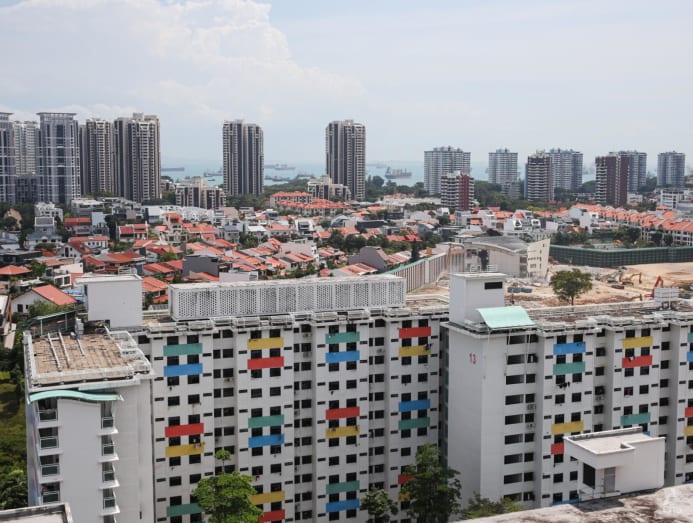
“If that area in particular has people who have been living there for a very long time, some over a few generations, then there is a likelihood that the voting patterns will be in favour of the incumbent,” said Dr Tan.
“However, if there are newer estates around there that form the bulk of that particular constituency, then there is a middle ground. The strategy might be trying to reach out to these newer voters.”
Dr Teo added that voters from different economic backgrounds also have different priorities, and politicians need to understand the ground sentiments and how different residents reach their voting decisions.
In short, East Coast GRC is no simpler a battleground today than it was in 2020, when it was a fiercely contested site between teams led by Deputy Prime Minister Heng Swee Keat from the People’s Action Party (PAP) and Ms Nicole Seah of the Workers’ Party (WP).
The PAP team comprised Mr Heng, Dr Maliki Osman, who was then Senior Minister of State for Defence and Foreign Affairs, Ms Jessica Tan, Ms Cheryl Chan and then-newcomer Mr Tan Kiat How, who was formerly chief executive officer of Infocomm Media Development Authority.
Aside from Ms Seah, the WP team was made up of lawyers Mr Terence Tan and Mr Dylan Ng, associate director at Singapore Cancer Society Mr Kenneth Foo and researcher Mr Abdul Shariff Aboo Kassim.
The PAP secured 53.41 per cent of the votes, making it one of the party's slimmest victories of the General Election. The PAP’s 2020 result in East Coast was a drop from the 60.73 per cent it achieved in the 2015 election, whereas the WP had its strongest performance in the GRC since 2006.
But since that hard-fought 2020 election, Ms Seah, a social media darling during her see-sawing political career, resigned from the WP after admitting to an extramarital affair with fellow party member and then-Aljunied MP Leon Perera.
Five years on, even with Ms Seah out of the picture, analysts told CNA TODAY that the contest is still expected to be a “close fight”, with the outcome hinging largely on the candidates that each party fields.
“Based on the last GE, the winning margin was pretty close, so it is likely that it will continue to be a close fight, especially if WP fields a team with credible candidates,” Dr Teo said.
“This would also be the case if sentiments on the ground are still positive towards WP despite Nicole Seah’s scandal.”
So what do voters of East Coast GRC want from their next slate of Members of Parliament (MPs)?
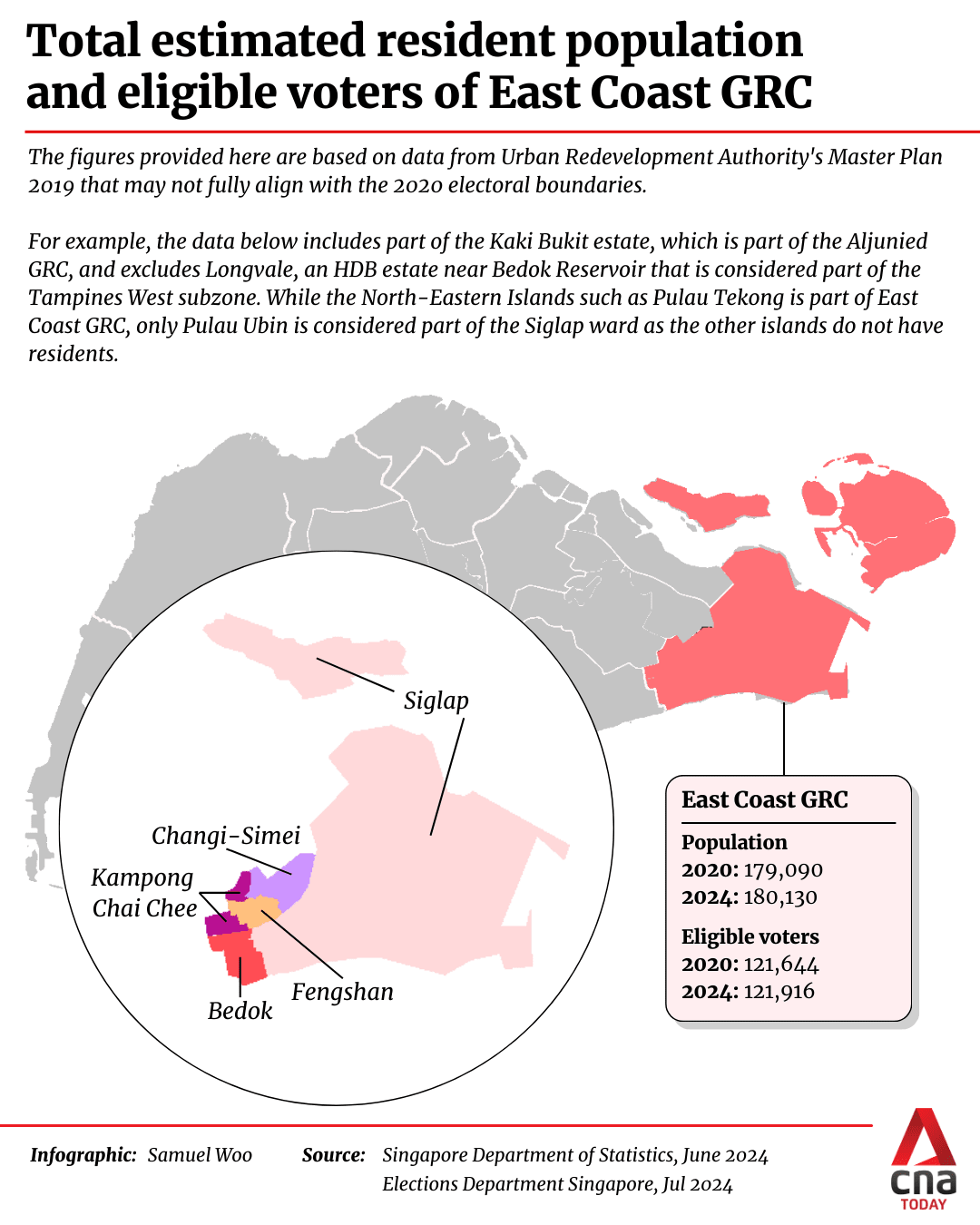
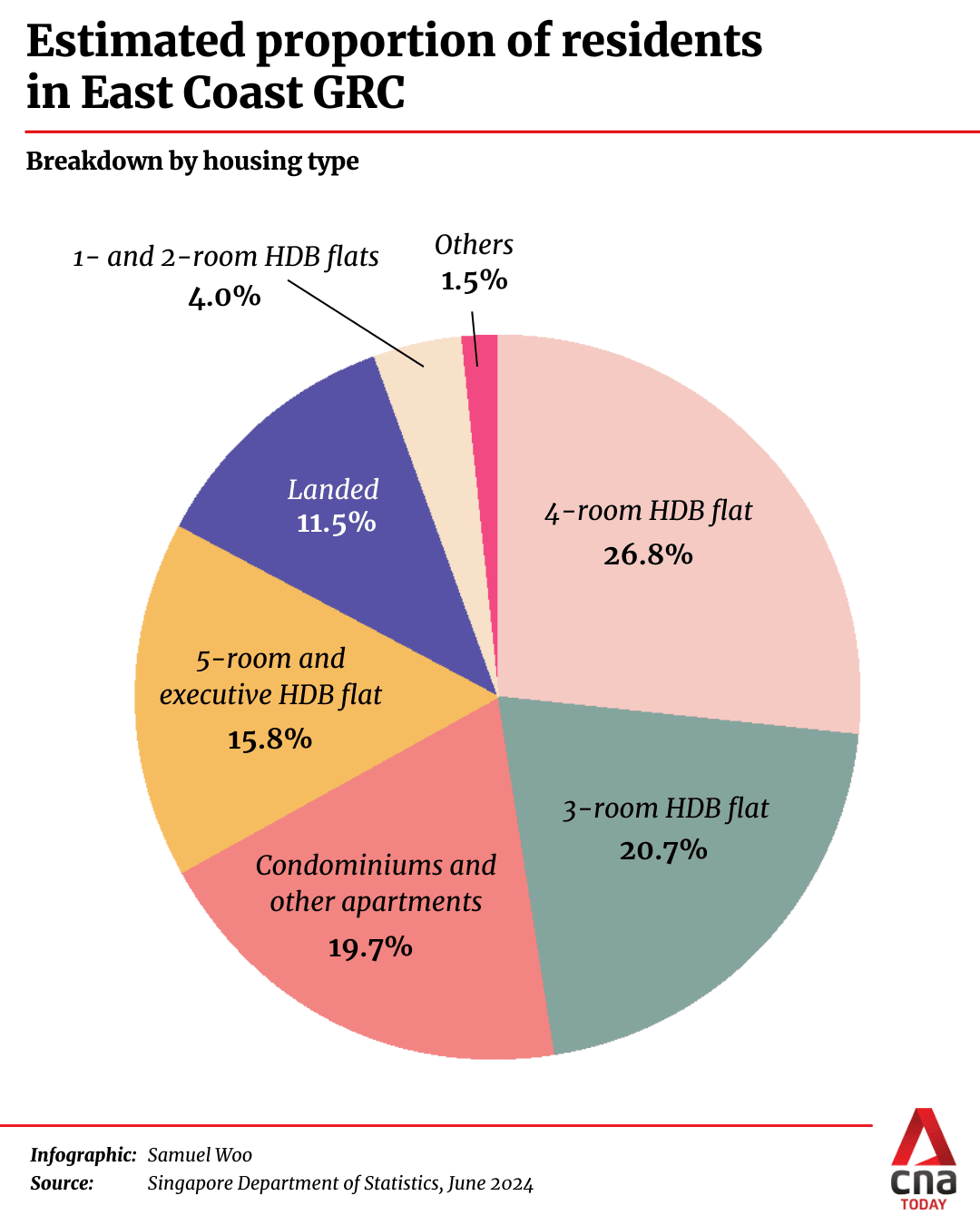
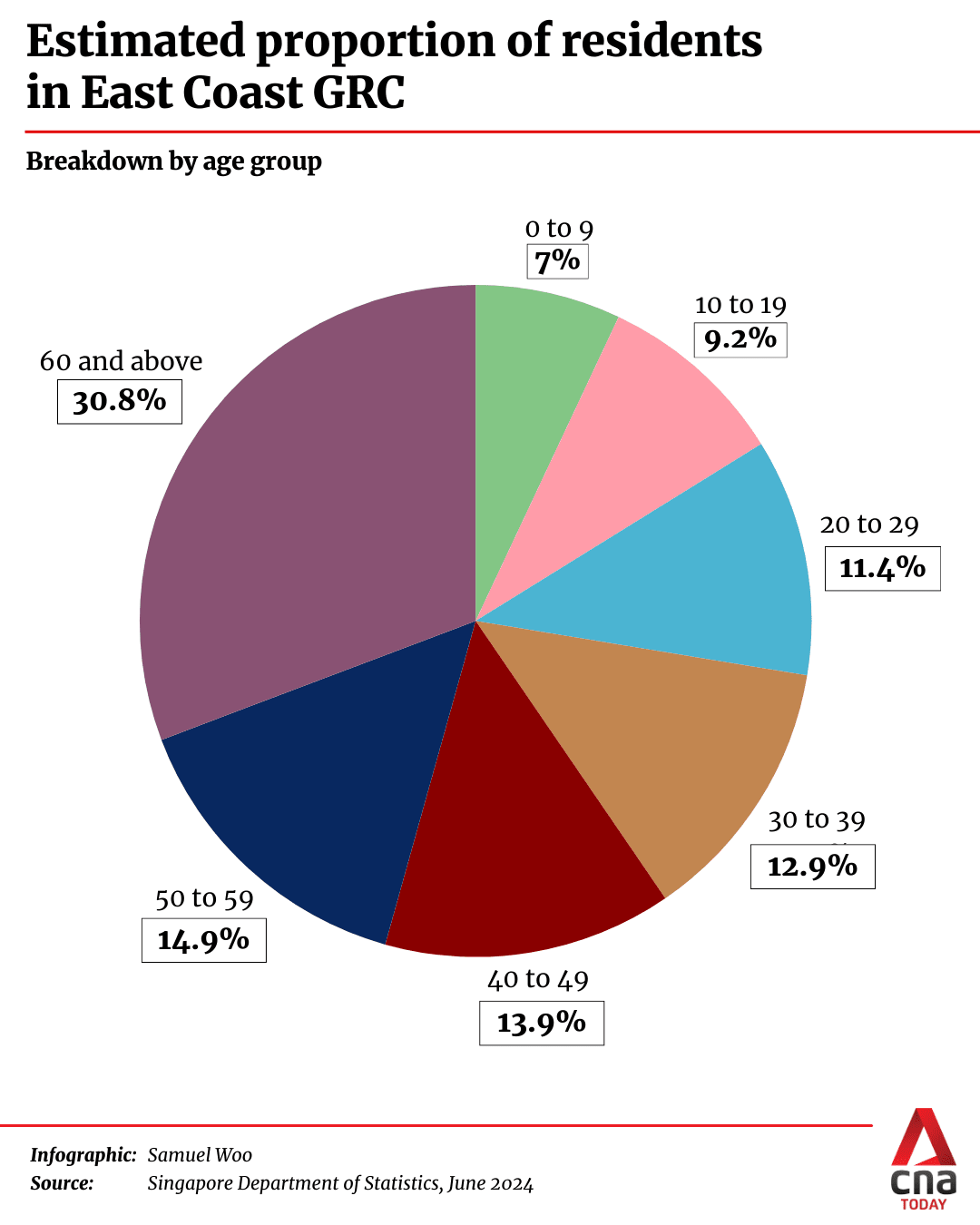
THE EAST COAST ELECTORATE
East Coast GRC is one of Singapore’s most diverse constituencies, with some of the country's oldest public housing blocks and rental flats in Bedok just down the road from lavish bungalows and gleaming condominiums in Siglap and Bayshore.
Pulau Ubin, which is a 15-minute boat ride away from the main island of Singapore, and other North-Eastern Islands, are also part of the East Coast GRC.
The constituency is divided into five divisions: Bedok, Siglap, Changi Simei, Fengshan and Kampong Chai Chee.
According to the Department of Statistics, roughly 180,130 residents lived in East Coast as of June 2024. About 67.4 per cent of residents live in public housing, while roughly 31.2 per cent live in private properties.
These numbers were calculated by adding up the geographical population data of several zones within the constituency based on the Urban Redevelopment Authority’s (URA) Master Plan 2019.
However, as the Master Plan 2019 differs from the electoral boundaries set by the Elections Department Singapore (ELD), the numbers may vary from the actual number of residents in the GRC.
For example, the URA data includes parts of the Kaki Bukit estate, which is under Aljunied GRC. The data also excludes Longvale, an HDB estate near Bedok Reservoir which is part of East Coast GRC but which URA has demarcated as part of Tampines West.
Several areas, such as Loyang Crescent, were also not calculated as they belong to different zoning districts. However, as these are industrial areas, their population numbers are likely to be insignificant.
According to the latest data from the Census of Population from 2020, 72.5 per cent of East Coast residents were Chinese, 14.2 per cent were Malay, 9 per cent were Indian and 4 per cent were of other ethnicities.
The census data is also based on URA's Master Plan 2019 and not on the electoral boundaries.
The latest revised voter rolls certified by ELD on July 21, 2024 shows that East Coast GRC has 121,916 eligible voters.
This is a 0.22 per cent increase from the 121,644 eligible voters in the electorate in 2020, when the last General Election was held.
WHAT EAST COAST RESIDENTS WANT
1. NATIONAL CONCERNS
For nearly all of the 50 residents interviewed by CNA TODAY, the concerns were strikingly consistent: The rising cost of living, job security and rising housing prices.
Their anxieties mirror those voiced by residents in Sengkang GRC.
The rising cost of living is impossible to ignore for supermarket procurement manager Ms Ng Shi Qi, who has been alarmed by the steady climb of prices on store shelves.
“The cost is increasing but our salary is the same,” said the 34-year-old Bedok resident. Besides rising costs of groceries, the price of housing is also on her mind as she hopes to buy a bigger HDB unit with her parents and brother.
“For resale units, the prices are so high… (the four-room units we want) are a minimum of S$600,000 a unit, which is out of the question for us,” said Ms Ng, whose family is looking for a unit in Bidadari, Hougang or Tampines.
Apart from cost concerns, the competitive job market and job security are also issues at the forefront of constituents' minds.
Siglap resident Shalyn Ng, 37, said: “There have been initiatives (to help Singaporean workers with) moving forward and career switches. But having been (retrenched) myself, a career switch is not easy, even with the support we get.”
More than half of residents that CNA TODAY spoke to raised concerns about assisting the GRC’s elderly population, who comprise nearly a third of the GRC’s population.
Their suggestions include increasing education efforts against scams and introducing more community activities for elderly residents.
Mr David, a 62-year-old retiree who declined to give his full name, said that there should be more anti-scam flyers in areas where elderly persons spend their time, such as Fengshan’s popular Bedok 85 Hawker Centre.
Three out of 10 retirees who spoke to CNA TODAY also asked for more efforts to engage elderly persons who may feel isolated at home.
Mdm Chang, a 69-year-old retiree who lives in the Siglap ward, said that she has been enjoying activities held by her Residents’ Committee but always sees the same few faces.
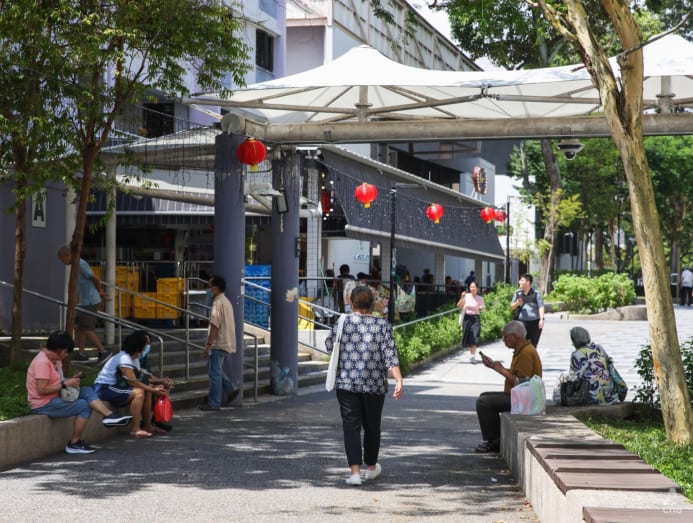
2. MORE AMENITIES IN SOME AREAS
Residents in the Bedok and Kampong Chai Chee wards were largely content, as the mature estates have had several facilities built and upgraded over the years.
Residents of the newer BTO estates in parts of Bedok South were pleased with the existing amenities in the Bedok Central area a stone's throw away.
In Simei, a smaller estate that about 38,470 residents call home, several residents said they make use of facilities in neighbouring Bedok and Tampines. However, some hoped for more amenities – such as more food courts and exercise facilities – nearer to home.
“There’s a link bridge to Tampines that allows me to go for a run and use Tampines Hub’s facilities… but it would be nice to have more facilities in Simei like another badminton court since it is always in use,” said 28-year-old administration worker Hannah Herman.
3. AGEING ESTATES
While living in a mature estate in Bedok might mean access to more amenities, some residents told CNA TODAY that the ageing infrastructure is an issue. After all, these are some of the oldest flats in Singapore.
Some residents from Blocks 1 to 4 along Bedok South Avenue 1, built in 1975, said that during heavy rainfall, water occasionally seeps into their homes through their kitchen windows.
“It’s not too bad for me, since I’m still able-bodied. But I worry for my elderly neighbours since it can be dangerous if they slip in their kitchen,” said Ms Cynthia Loh, 67, a tour guide and Bedok resident for over 20 years.
“We’ve asked the town council (for help) but there’s not much they can do, I think.”
While she lauded the Home Improvement Programme, which resolves common maintenance problems of ageing flats and was conducted on their estate last year, she said some issues, such as the water leaks, could not be resolved.
In response to queries from CNA TODAY, PAP's Mr Heng noted that many housing estates in the East Coast, especially those around Bedok Town Centre and Bedok South, were built in the 1970s, and residents were much younger when they moved in.
The East Coast Town Council has been working with agencies like HDB to rejuvenate the estate, he added.
These efforts include installing more senior-friendly fixtures, such as ramps, to help the elderly with mobility issues leave their homes and participate in community activities.
Ageing homes are not just a concern for HDB dwellers – some 144 terraced and semi-detached houses in Jalan Chempaka Puteh, Jalan Chempaka Kuning and Bedok Road are facing the end of their leases, which run out by August 2034.
With about nine years left, residents such as 77-year-old retiree Soo Yok Tai have sought help from MP Cheryl Chan to get in touch with Camelot Trust, the trust firm that manages the estate.
"We’re in limbo and are not sure what to do once our lease is up,” said Mr Soo, who bought his home in 1972. “I try not to stress about it but I do worry about where I can live once the lease is up.”
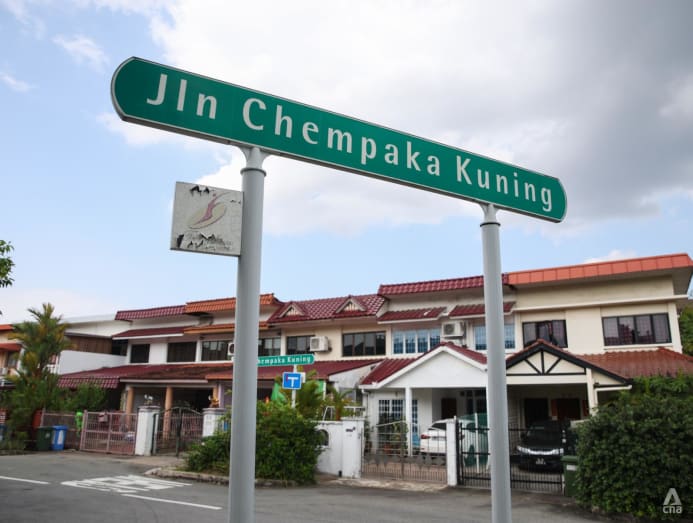
In a reply to a resident dated Dec 30, 2024 seen by CNA TODAY, Camelot Trust said it is aware tenants want an indication about whether their leases can be renewed, but said it could not provide details due to confidentiality obligations.
"(There are) concerns, especially from the older retirees who may not have as much savings, about what will happen if the lease runs out," Mr Cheong said. "With the years running out, this issue will be on our minds during the coming elections."
In response to queries by CNA TODAY, Ms Chan said this issue affects around 100 landed houses.
"We can appreciate the anxiety of these families as their leases are coming up," said Ms Chan, who has been trying to encourage discussion between the legal owner of the land and the affected residents.
4. ACCESSIBILITY & SAFETY
Retiree Madam Chang, who only wanted to be known by her last name, said there are still many motorised personal mobility device (PMD) riders on pedestrian walkways, making it dangerous for the elderly in the area.
“There are a lot of seniors and people need to respect that they walk slowly,” said Mdm Chang, the Siglap resident.
Meanwhile, Ms Araleen Chang, who is not related to Mdm Chang, hopes that HDB flats in Siglap will be more wheelchair accessible. Her grandmother uses a wheelchair and often relies on sheltered walkways and lifts to get around.
“I think more sheltered areas would be a great thing,” said the 25-year-old nurse. She has faced challenges finding a sheltered area for a taxi to pick up her grandmother, and pushing the wheelchair while holding an umbrella can be difficult.
5. ESTATE CLEANLINESS AROUND RENTAL BLOCKS
Across the East Coast GRC, residents said their estates were mostly clean. However, those living near rental blocks have noticed more litter compared with other estates.
When CNA TODAY visited three rental blocks on Feb 12, litter such as tissue paper and plastic bags were seen around the void deck and patches of grass nearby. In contrast, the non-rental blocks just nearby were pristine.
“Usually it does not look so bad because the cleaners are very efficient here,” said a retiree in her 70s who lives in a rental flat along Bedok South road. She declined to be named for privacy reasons.
Other residents said that litter is only apparent when the estate’s cleaner does not visit the area for two days or more.
Several, like 53-year-old civil servant Lim Choon Seng, said that more efforts to integrate rental block occupants into the estate could help cultivate an increased level of responsibility for the neighbourhood and reduce anti-neighbourly behaviour.
In response to queries from CNA TODAY, the East Coast Town Council said that while cleanliness is an important consideration for its residents, high-rise littering can be a complex matter.
"It goes beyond enforcement. There are often other social and familial issues at play," the town council said.
It added that it tries to work with volunteers to engage the individual who has been littering, find ways to help and prevent future occurrences.
WILL THE NICOLE SEAH CONTROVERSY MATTER?
When it came to the issue of Ms Seah’s extra-marital affair with senior WP member Mr Perera, East Coast residents had mixed views.
Some felt the incident was a personal matter and will not factor into their voting decision.
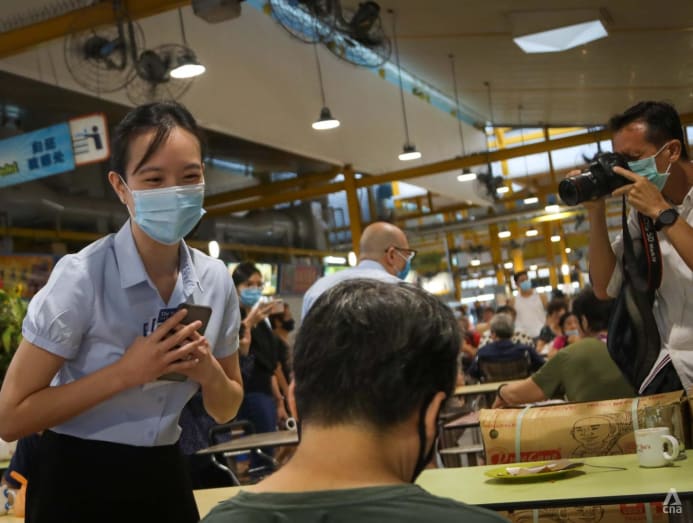
But others said that the affair has made them more concerned about political candidates' moral character.
“One bad apple can ruin it all. The parties all need to do better background checks on their characters and make sure they prioritise serving their constituency,” said Mdm Chang.
Meanwhile, Siglap resident Ms Siti Mardhiah, 30, said the scandal itself is not as important as how one overcomes it and stays professional.
“I think she did the right thing (by resigning), respectfully. Because I think she knows it's going to affect the party,” said the operations executive, adding that this incident did not change her impression of WP.
Others, like Fengshan resident Ms Priscilla Seah, no relation to Ms Nicole Seah, felt more strongly about Ms Seah’s departure from the WP.
“It was very sad. I think many people had placed hopes on her,” said the retiree in her 60s.
Ms Priscilla Seah said Ms Nicole Seah seemed like a “fairly formidable” candidate even when she was part of the National Solidarity Party (NSP). Under the NSP flag, Ms Nicole Seah contested against a PAP team led by then-Senior Minister Goh Chok Tong for the Marine Parade GRC ward in 2015 and garnered about 43.4 per cent of the votes.
“It was a pity that something like that happened. But then again, we are generally an Asian society, and Asian societies tend to be conservative,” said Ms Priscilla Seah.
“Maybe, hopefully, she will come back and run again one day.”
WHAT ABOUT THE EAST COAST PLAN?
Since the last election, East Coast GRC MPs have implemented estate improvements as part of their "East Coast Plan", which aims to make the constituency more caring, vibrant and green.
Under the plan, residents have had access to several initiatives, such as an East Coast Internship Programme that exposes youths to the work of the People’s Association and grassroots organisations.
To aid lower and middle-income families, the PAP MPs have also launched several schemes to subsidise grocery costs.
Just last month, Mr Heng, who is also the advisor to East Coast GRC's grassroots organisations, announced new community spaces with facilities such as adventure playgrounds, fitness zones and pet areas.
Mr Heng told CNA TODAY on Friday (Feb 14) that East Coast residents "are at the heart of the East Coast Plan".
"The East Coast Plan has something for everyone... Due to the diverse nature of East Coast, each MP further adapts GRC-wide initiatives to meet the needs of local estates as the profile and needs of residents differ," he said.
For example, residents in Kampong Chai Chee get discounts for essentials at merchants in the estate through the Gd Lobangs @ KCC programme.

The MPs are also taking a more aggressive approach to their social media strategy. This year, they have posted several curated videos with the hashtag #eastcoastplan on their own social media pages that showcases several initatives.
In one video published on Feb 12, Mr Heng Swee Keat spoke about how interns under the East Coast Internship Programme provided a cat therapy session for seniors in the constituency.
Despite these efforts, however, only eight out of the 50 people who spoke to CNA TODAY could name an initiative that came under the plan, and none could explain what the East Coast Plan was.
Some also misunderstood the East Coast Plan. For example, one resident said the plan was related to land reclamation in the Bayfront area “to turn it into Holland Village”.
Another woman, who lives in Bedok and is in her 80s, thought it only involved more long-term infrastructure changes, such as building more shopping malls in her estate.
NEW FACES AND SHIFTING BOUNDARIES
East Coast GRC has shifted boundaries in the previous two elections, with the Fengshan ward carved out of the GRC ahead of GE2015 as a Single Member Constituency, before being subsumed back into to the GRC for GE2020.
Experts said the constituency’s boundaries could shift again before the coming election, which must be held by this November.
This is because of the high electors-to-MP ratio in neighbouring Tampines and Pasir Ris-Punggol GRCs – some of the voters in these GRCs might become East Coast constituents ahead of the next election.
In reviewing the constituency boundaries, the Electoral Boundaries Review Committee (EBRC) considers the number of electors to each MP. In the last review in 2020, there were an average of 29,200 electors to each MP.
Based on the latest revised voter rolls certified by ELD on July 21, 2024, East Coast GRC has one MP for every 24,383 electors.
Meanwhile, Tampines GRC has one MP for about 32,894 electors while Pasir Ris-Punggol has one MP for roughly 36,064 electors. This means that boundaries may be shifted so as to reduce the ratio in these constituencies, said political experts.
“When one electoral division's electoral boundaries are adjusted, there can be a knock-on effect on other electoral divisions that are contiguous to East Coast GRC,” said Associate Professor of Law at Singapore Management University Eugene Tan.
Experts also said the constituency will continue to be a fierce battleground depending on the party line-ups from the PAP and WP, as well as the key municipal and national issues set to feature during the election campaign.
With the close fight, experts said there could be potential changes to the PAP’s slate in the GRC.
Assoc Prof Tan told CNA TODAY that the PAP may field a new face as long-time MP Jessica Tan, 58, who has served the constituency for 19 years, is likely to step aside.
Analysts have a guess as to her replacement: Ms Melissa Tan, a waste management firm boss and long-time PAP volunteer, has been spotted walking the Fengshan and Changi Simei wards.
The WP will also need to field new candidates if they contest the GRC, as Ms Seah and Mr Terence Tan have stepped down from the party since the last election.
Among those rumoured to be in the running as potential candidates is WP volunteer Jeraldine Phneah, 34, who was spotted in WP's social media posts in December on walkabouts and outreach activities in both East Coast and Jalan Besar GRCs.
Another potential new face is Mr Ang Boon Yaw, 43, a senior associate with Yeo Marini Law Corporation. He was also featured in social media posts walking the ground this month. The long-time WP volunteer has been in the party’s central executive committee for two terms and is currently its deputy organising secretary.
Five residents told CNA TODAY they have seen the opposition party members walking around in Bedok, Kampong Chai Chee and Fenghsan. However, the residents were uncertain if they had met potential candidates or simply party volunteers.
WP's chief Pritam Singh has said that the party often keeps its cards close to its chest as it serves “little purpose” to reveal candidates before Nomination Day.
Dr Teo of IPS said that because WP is the largest opposition party in Singapore, with a certain reputation and credibility with voters, the electorate might want to know sooner which candidates are being fielded.
“That said, things could also change for voters when PAP’s slate is revealed, because with the areas that are hotly contested, voters would likely vote based on what they think of both teams, rather than just what they think of the opposition team,” Dr Teo said.
She added that with the EBRC review currently underway, election strategies might change when the report is out.
“Revealing candidates too early might mean that they cannot adjust their election plan in a more flexible and optimal manner,” Dr Teo said.

WHERE WILL THE EAST WIND BLOW?
Ultimately, the diverse electorate will have various considerations in mind when casting their vote in the coming elections, said experts.
A handful of residents told CNA TODAY the moral character of the candidate will be their main consideration, while others said they want a representative who will address both national and municipal issues.
To be sure, residents will be watching closely the candidates put forth by both the ruling party and opposition.
First-time general election voter Mr Alistair Ng, 24, is keeping his options open and looking at what both parties put out that can inform his vote – specifically once the elections are in full swing and the candidates from both parties are known.
As for Ms Ng, the resident who lives in Siglap, whoever wins her ward will have their job cut out for them as she plans to vote based on who can meet her concerns as a mother of two young children.
“Whoever sits in the seat, they need to do their job. If they don't, everyone will call them out,” she said.
“If a new party actually gets the seat, they just have to prove themselves. If they don't, then it's very natural, they're going to get pushed out. Then the old might come back, or someone who's stronger might replace them.”
Editor's note: A previous version of the article stated that Ms Jessica Tan and Ms Cheryl Chan were political office holders. They are not. We apologise for the error.



















